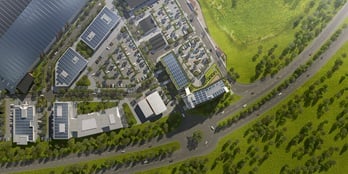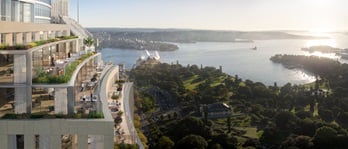The brothers behind the bricks: Exploring Wesley place's philanthropic history
By proceeding you confirm that you are a resident of Australia or New Zealand accessing this website from within Australia or New Zealand and you represent, warrant and agree that:
- you are not in the United States or a “U.S. person”, as defined in Regulation S under the U.S. Securities Act of 1933, as amended (“U.S. Person”), nor are you acting for the account or benefit of a U.S. Person;
- you will not make a copy of the documents on this website available to, or distribute a copy of such documents to, or for the account or benefit of, any U.S. Person or any person in any other place in which, or to any other person to whom, it would be unlawful to do so; and
- the state, territory or province and postcode provided by you below for your primary residence in Australia or New Zealand are true and accurate.
Unfortunately, legal restrictions prevent us from allowing you access to this website. If you have any questions, please contact us by e-mail by clicking on the link below.
20th century Melbourne was home to a diverse range of pioneers, none more interesting than the multitude of extraordinary people who contributed to the creation of the Princess Mary Club. A vision of Rev. Hoban, the Princess Mary Club was created to provide a sanctuary for young women in Melbourne. The incredible people that contributed towards delivering Rev. Hoban’s vision included the Myer Emporium, George and Allen Tye, Joseph Rank, the TJ Summer Trust, the Henry Berry fund, the Edmund Wilson Fund, the Walter and Eliza Hall Trust and Hoyts (just to name a few!).
Among these generous benefactors of the Princess Mary Club, were brothers Alfred and George Nicholas, devout Methodists, whose significant (and often anonymous) benefaction helped bring many of the heritage buildings at Wesley Place to life.
From historic art and facilities at the Wesley Church and Nicholas Hall, to headquarters for philanthropist groups like the Princess Mary Club, the Nicholas Brothers helped make Wesley Place’s values of inclusivity, social progress and charity a reality.
As our future precinct evolves, we can’t let these stories of generosity and evolution get lost in the pages of our history books. So, to follow on from “A Ladies’ Legacy” in our recent newsletter, we sat down with Alfred Nicholas’s great-granddaughter Sophie Paterson to find out more about her family’s revolutionary history. With an upbringing set to the backdrop of our precinct’s evolution, Sophie helped us unearth the incredible work achieved by the Princess Mary Club and the Nicholas Brothers in the early 20th century…
Meet the Nicholas Brothers: Two men, countless contributions
Alfred Nicholas was born on 14 September 1881 in early Melbourne. He (a grocer and merchant by trade) and his brother George Nicholas (a renowned pharmacist) donated a staggering 50 per cent of their estate to various philanthropical causes. From historical buildings that provided accommodation for vulnerable women, to sprawling community gardens in places like Auburn and Sassafras (which still exist today), the brothers’ generous contributions to early Melbourne society were a key part of the city’s evolution.
The scale of their generosity obviously begs the question: Where did the money come from?
Although an illness-ridden childhood prevented Alfred from attaining a full education, the young man’s ambition helped him defy the odds, going on to become one of Melbourne’s most successful businessmen, in partnership with George.
“You may have heard of the Aspro empire,” said Alfred’s great granddaughter Sophie Paterson in our recent interview. “George Nicholas got wind that European-made aspirin was banned from import into Australia during WW1 and set about re-inventing the medication – with old kerosene tins and his wife’s kitchen utensils.
“With Alfred’s dedication and George’s pharmaceutical genius, they sort of happened upon gold. They were awarded the patent for Australian-made aspirin, and the subsequent Aspro business expanded into global markets throughout the 20th century.”
But their success was not greedy – the brothers often donated money they didn’t even have (during the time of the depression), taking loans from the bank in order to support local community projects. Sophie mused:
“Donating money you don’t yet own would be relatively unheard of today. They were helping those in need, even when they themselves were in need. That generosity really brought the Wesley Place community and surrounding city to life.”
Building benefaction: The bricks the brothers built
Much of the Nicholas family’s contributions were donated to the restoration and establishment of various community facilities around Melbourne – from new buildings for the students at Wesley College and Methodist Ladies College, to the original Seafarers Mission, Lord Somers Camp, The Nicholas Pavilion at the Showgrounds, the well-frequented Nicholas Building at 37 Swanston St and many Melbourne hospitals and universities.
Alfred’s own house in the Dandenong Ranges was donated as a hospital for soldiers in WWII and is currently being restored as a hotel, while Parks Victoria is also restoring the Alfred Nicholas Gardens in Sherbrooke for recreational use by the community.
“Even with all these examples of their legacy, the full extent of my family’s philanthropy only really surfaced later on in our lives,” says Sophie. “So many of their contributions were made anonymously. It has been a very exciting and moving process in terms of learning about their generosity and the roles they played in the early Melbourne community.”
Another brick in the wall for the Princess Mary Club
One of the Nicholas brothers’ most renowned examples of philanthropy was their contribution towards the 1926 establishment and later preservation of the Princess Mary Club (PMC) – a sanctuary in the city to empower female’s migrating from the country to the city in search of work opportunities.
The brothers were closely affiliated with the neighbouring Wesley Church, and were acutely moved by the surrounding societal plight of the homeless, the vulnerable and those affected by the impact of the great depression. So, with financial backing, the brothers helped build one of the city’s first and most frequented community hostels. The Lonsdale St Princess Mary Club headquarters most famously housed a legendary group of women whose work helped house, counsel, feed and educate around 120 of Melbourne’s brightest young women.
“It was a time of significant change and empowerment in terms of gender equality in early society, with women wanting to enter the workforce or study and have more authority in society,” says Sophie. “But young ladies were often moving to the city from rural areas in order to work and study with nowhere to stay and no community to support their endeavours. The PMC became a discrimination-free home away from home for women of all backgrounds and lines of work, and PMC’s residents went on to do great things.”
Having the support of the Club empowered pioneering young PMC residents to pursue careers in everything from radiography and dentistry to hairdressing and administration. Resident Ailsa Trundle even became the first women to become a partner in an architecture firm.
But the Nicholas Brothers’ support at Wesley Place extended beyond the PMC: “Alfred also gave money to the restoration of the Church, as seen by the beautiful stained glass window dedicated to the life of my great grandfather. Also to building the Nicholas Hall.”
These buildings, and even the aforementioned stained glass window, remain key parts of our heritage restoration works at Wesley Place, with specialist heritage experts working to preserve these legacies for the future community.
A legacy lives on
Although the Nicholas Brothers themselves are no longer around to keep their legacy alive, their family and the local Melbourne community are future-proofing their stories for generations to come.
“We still sponsor events and accolades in our great grandfather’s name, Wesley College has Nicholas awards, and Melbourne is scattered with still-standing examples of their generosity.”
Sophie herself is a nurse, following in her family’s footsteps by choosing a community-driven career. “I think we all inherited a bit of Alfred’s generous spirit. It’s certainly been my calling in life to help others and as a nurse I get to make a difference in people’s lives every day.”
We are proud to be breaking ground on such legendary foundations at Wesley Place, and will continue to share these stories as and after our precinct evolves. After all, we would not be able to build new legacies in such significant heritage spaces if it wasn’t for the generosity of foresight of people like the Nicholas Brothers and the many other contributors involved in the Princess Mary Club.


